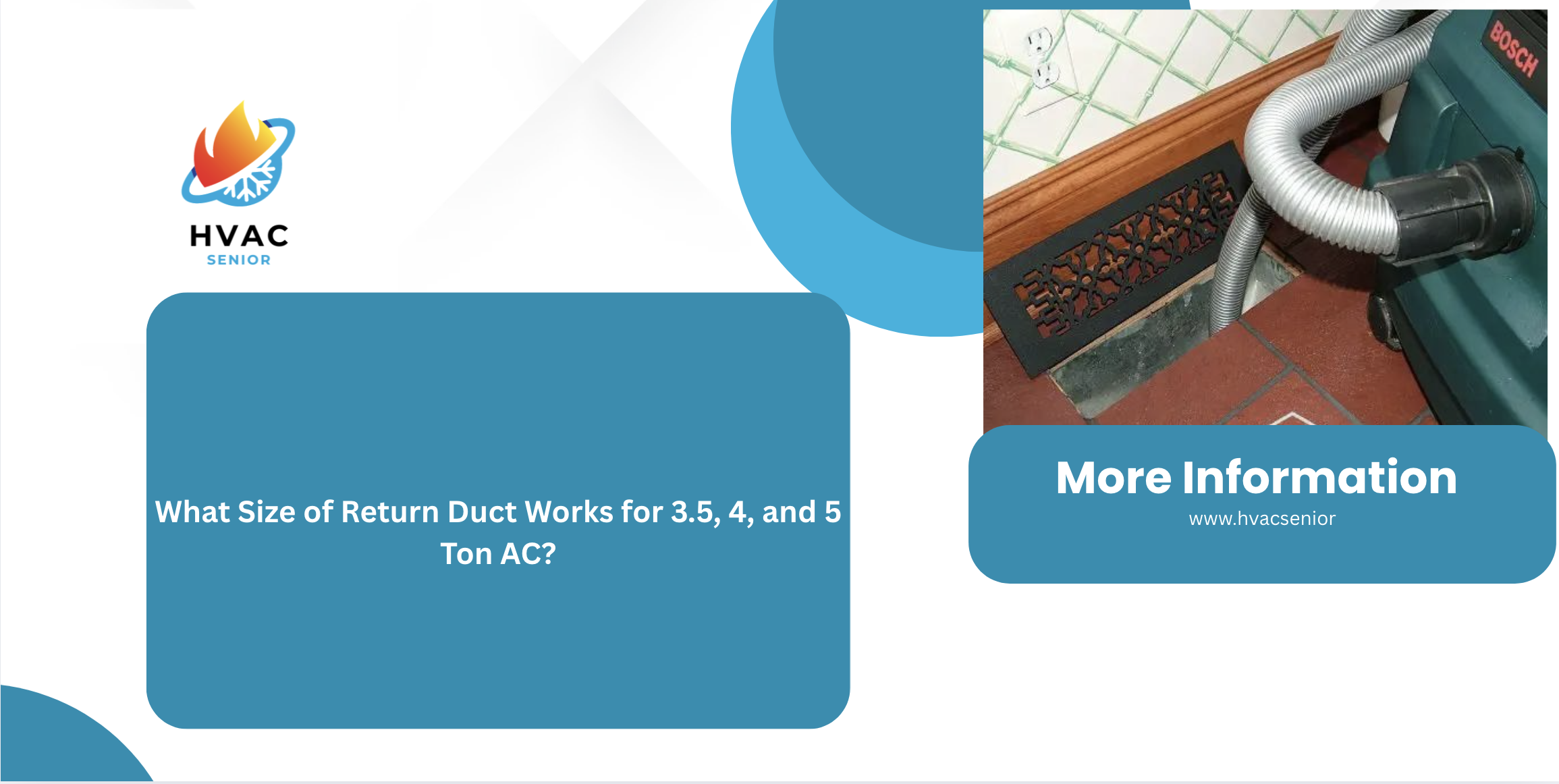Ever walked into a room and thought, “Why is it still warm when the AC is running full blast?” You’re not alone — and believe it or not, the culprit might not be your air conditioner at all. It could be your return duct quietly choking your system’s airflow behind the walls.
If you’ve got a 3.5-ton, 4-ton, or 5-ton AC, this post will help you know exactly what return duct size you need — no deceptive math, just good ol’ common sense.
Grab your coffee, HVAC enthusiast! Let’s get silly and keep things simple.
First Things First: What is a Return Duct, Anyway?
Visualize your AC as lungs.
- The supply ducts are lungs blowing out cool air.
- Return ducts are the lungs breathing warm air out of your rooms.
Both need to function as one. If one side is clogged (or undersized), your system can’t “breathe.” That’s when you’re experiencing:
- Poor cooling performance
- Higher electricity bills
- Frozen coils
- And an unhappy homeowner (you!)
So, yes — return ducts are not just metal tubes; they’re the lifeblood of your comfort.
Fast Review: What’s a “Ton” in Air Conditioning?
If you’ve ever wondered what a “3.5-ton AC” actually means — it’s not the physical weight!
One ton of cooling equals 12,000 BTUs per hour (BTU = British Thermal Unit).
So:
- 3.5 tons = 42,000 BTU/hr
- 4 tons = 48,000 BTU/hr
- 5 tons = 60,000 BTU/hr
Now, each “ton” of AC typically requires around 400 cubic feet per minute (CFM) of airflow. That means your system needs to move:
- 3.5 ton → 1,400 CFM
- 4 ton → 1,600 CFM
- 5 ton → 2,000 CFM
Plenty of air! And your return duct has to be large enough to hold that much without restricting it.
Also read: High Cool vs High Fan: What AC Mode Reigns Supreme?
Rule of Thumb: Ideal Return Duct Sizes
This is the simple part — no HVAC degree required.
Based on airflow and friction loss, the below duct sizes are the recommended sizes for every system size:
| AC Capacity | Airflow (CFM) | Typical Return Duct Size | Duct Type |
| 3.5 Ton | 1,400 CFM | 18” round or 20” x 20” rectangular | Main return |
| 4 Ton | 1,600 CFM | 20” round or 22” x 22” rectangular | Main return |
| 5 Ton | 2,000 CFM | 22” round or 24” x 24” rectangular | Main return |
Tip: For long or multiply turned return duct, you might need to upsize for reducing pressure loss. Straight, short runs can usually stay with the sizes mentioned.
Try This: Quick Airflow Test at Home
Want to know if your return duct is currently undersized?
Here’s a simple test that doesn’t require tools:
- Turn on your AC.
- Place a tissue near the return grille.
- If it snaps on firmly to the grille — excellent airflow.
- If it barely budges or falls off — you’ve got restricted return flow.
Side tip: Pay attention for whistling noises nearby the return vent. That’s typically an indication the system is air-starved.
What If Your Return Duct Is Too Small?
Let’s pretend.
Attempt drinking a milkshake through a coffee stirrer straw.
That’s what your AC goes through with an undersized return duct.
Here’s what happens:
- The blower motor has to work harder → dies earlier.
- Airflow is reduced → rooms stay unevenly cooled.
- Evaporator coil freezes → system stops cooling.
- Energy bills go up → your wallet cries.
And the worst news? You think you need a new AC, when what you actually needed was a bigger return duct.
Balancing Multiple Returns
Big house? Then one return grille is not sufficient.
Big systems — especially 4 and 5-ton systems — are serviced better by multiple return air grilles.
Here’s how you can balance it:
- Split the return airflow.
For example, a 5-ton system (2,000 CFM) can use:- Two 16” returns (1,000 CFM each), or
- Three 14” returns (about 650 CFM each).
It stops air from flowing evenly throughout your house and makes noise and static pressure.
Reader Challenge: Can You Recognize These Return Issues?
The next time you go check on your vents, look for these clues.
Post your findings in the comments — let’s see just how “HVAC smart” you are!
- Dust buildup along edges of grille → Inefficient airflow.
- Whistling noise when AC is running → Duct too small.
- Hot or cold spots in particular rooms → Unbalanced air return.
- Filter clogging too soon → Clogged or undersized return.
- If you said yes to any of the foregoing, your return ductwork may be restricted or undersized.
Cool Fact: Return Air Affects More Than Comfort
Did you know that your return air duct also affects indoor air quality?
A correctly sized and filtered return duct will do the following:
- Eliminate dust and allergens.
- Reduce humidity fluctuations.
- Ensure the coil on the system is clean.
- Make airflow in general more effective.
So when you upsize your return duct, you’re not just helping your AC — you’re basically helping you breathe better air.
Also read: Ceiling Fan Clicking Noises at High Speed.
When to Call in a Pro (and What to Ask)
Sometimes, it takes a little math from a pro to size the duct — especially if your space is complex. When you have an HVAC pro come in, ask them these questions
- What is the static pressure across my return?
- How many CFMs are reaching the blower?
- Do I need to add additional returns or upgrade the main one?
Pro tip: If your system’s noisy or your filters get vacuumed in, those’re big red flags your return duct is too small.
Bonus: Duct Sizing Formula (For the Curious DIYers)
You’re a numbers geek, huh? Here’s the simplified explanation of how techs calculate it:
DuctArea(sq.in.)=CFMVelocity(ft/min)Duct Area (sq. in.) = \frac{CFM}{Velocity (ft/min)}DuctArea(sq.in.)=Velocity(ft/min)CFM
Most systems use around 700–900 ft/min for returns.
So, for a 4-ton unit (1,600 CFM) at 800 ft/min:
1600÷800=2sq.ft.→abouta22”x22”duct.1600 ÷ 800 = 2 sq. ft. → about a 22” x 22” duct.1600÷800=2sq.ft.→abouta22”x22”duct.
See? You’re already a pro thinker.
Wrapping It Up: The Quick Guide Recap
Here’s your cheat sheet before you go:
| AC Size | Required Airflow (CFM) | Recommended Return Duct Size |
| 3.5 Ton | 1,400 | 18” round or 20”x20” rectangular |
| 4 Ton | 1,600 | 20” round or 22”x22” rectangular |
| 5 Ton | 2,000 | 22” round or 24”x24” rectangular |
✅ Bigger is better than smaller.
✅ Add multiple returns for even cooling.
✅ Always use smooth ducts with the minimal number of bends.
✅ Keep filters clean to guarantee airflow.
Final Thought: Your AC Deserves to Breathe
Your air conditioner is only as good as the air it can pass, after all.
If you’ve invested in a 4 or 5-ton system, don’t choke it with a 2-ton return duct!
Give your system room to breathe and it’ll reward you with:
- Quieter operation,
- Lower bills,
- Even cooling the whole summer.
Go ahead, pick up a flashlight tonight, peek in the back of that return grille, and ask yourself:
“Is my AC breathing good?”















